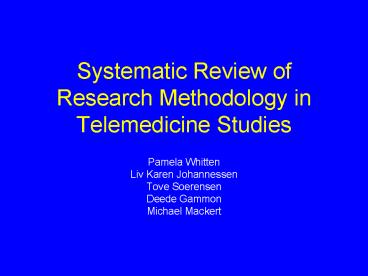Systematic Review of Research Methodology in Telemedicine Studies - PowerPoint PPT Presentation
1 / 11
Title:
Systematic Review of Research Methodology in Telemedicine Studies
Description:
Were results presented in qualitative and/or quantitative fashion? Methodology ... explicitly stated RQs prevent true critique of study design. Kuhn Basic Tenet: ... – PowerPoint PPT presentation
Number of Views:75
Avg rating:3.0/5.0
Title: Systematic Review of Research Methodology in Telemedicine Studies
1
Systematic Review of Research Methodology in
Telemedicine Studies
- Pamela Whitten
- Liv Karen Johannessen
- Tove Soerensen
- Deede Gammon
- Michael Mackert
2
- Article in press, Journal of Telemedicine and
Telecare
3
Rationale
- Review articles struggling to document large
scale evidence of the positive effect of
telemedicine on health and cost outcomes - Previous review articles claim methodology often
poor in published papers
4
Research Questions
- What is the incidence of theory testing in
telemedicine literature? What theories are
actually tested? - What of studies clearly report specific study
variables (e.g., objective, hypotheses/RQ, and
type of subjects, randomization, units of
analysis, location, time frame) - What data collection strategies and analyses were
employed? - Were results presented in qualitative and/or
quantitative fashion?
5
Methodology
- Keyword search strategy employed on 15 scientific
databases - Initial search yielded more than 10,000 articles
- Articles then assessed against inclusion criteria
(e.g., published post 1990, included data,
included some form of a methods section, etc.) - N1615 articles
- Inter-rater reliability (Cohens Kappa) exceeded
.80 for three pairs of coder
6
Results
- 5 mention theory or paradigmatic approach
- 96 report overall study aim
- Seek some form of outcome (80)
- Test technical feasibility (13)
- Address hypothetical issues (7)
- 11 provided explicit hypotheses or research
questions
7
Results (cont.)
- 26 did not provide of subjects
- For those reporting patients as subjects
- Median 47
- 65 had sample size of 100 or less
- For those reporting providers as subjects
- Median 29
- 86 had sample size of 100 or less
- 11 reported randomization for patient studies
and 4 for provider studies (most papers did not
even mention subject selection strategies)
8
Results
- 83 reported location of study
- 34 in US
- 24 Europe
- Data collection
- Patients
- 31 multiple data collection strategies
- Image Transfer (35)
- Providers
- 18 multiple data collection strategies
- Surveys (60)
9
Results
- Few significant relationships
- Use of theory and presence of formal research
questions (r0.25, Plt0.01) - Research questions and study aim (r0.067,
Plt0.01) - Inclusion of theory and study based on an actual
intervention (r-0.069, Plt0.01)
10
Discussion
- These methodological challenges not owned by
telemedicine - Implications of missing methodological details
should not be underestimated - Time impacts technologies
- Subject selection and sample size matter
- Lack of explicitly stated RQs prevent true
critique of study design
11
Kuhn Basic Tenet
- The existence of intertwined theoretical beliefs
and methodological strategies make it possible
for a field to evaluate its own body of research































